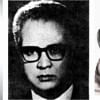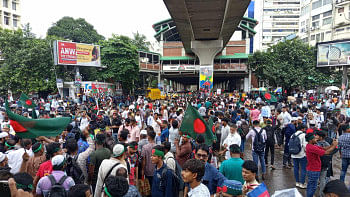Fragments from a pre-Partition childhood

I am Kaniz Alia also known by my nickname Baby. I was born in March 1933. I have no memory of my mother. I was two and a half years old when she passed away, and my sister (Kaniz Fatema, nicknamed Kochi) was 13 days old.
My mother, Sara Begum, and my father, Syed Golam Kabir had five children over a span of nine and a half years between 1926 and 1935. She was married off at a very early age, and as was the practice in those days, her firstborn was raised by our maternal grandparents. A young mother, Maa was not able to rear an infant with another on the way.
My eldest brother, Boro Bhaiya, lived with my grandparents, Nana and Mini, till he was seven. Maa brought him back to live with her because his studies were suffering. My brother would lament about being deprived of a mother's love from a young age. He would always say the two and a half years he spent with Maa were the best years of his life, but Boro Bhaiya was thoroughly spoilt by my grandparents as well.
Maa's second child was a girl. Kaniz Zohra, nicknamed Piyari, was born in 1927. When my mother's third child, Syed Humayun Kabir, Choto Bhaiya, was born in 1931, Maa handed over the baby boy to a nanny. We called our nanny, Khilai, a name derived from Calcuttan Urdu, meaning one who feeds. Maa continued to breastfeed my elder sister even after my Choto Bhaiya was born. Maa was very fond of girls. She also breastfed me until her youngest was born two years later. The first three children were born wherever my father happened to be posted as a member of the Bengal Civil Service. My younger sister and I were also born in Calcutta, but by that time my parents lived in a rented house.
Khilai came to live at my parent's house soon after Humayun was born and was a part of the family until she passed away in the 1970s. Much of what we know about Maa we heard from Khilai. Khilai said that Maa would hand over the baby boy to her with all the necessary items for the day, such as milk and nappies, and turn her attention to her daughter Piyari. Maa's attachment to Piyari was unusual in those days and very indulgent. Once she made a large bowl of roshogolla (syrupy sweets), and let Boro Apa play with the entire bowl of sweets, as she would not have it any other way until it was one royal mess.
During her relatively short life, my mother acquired a reputation for being a Swadeshi, a Bangali, and something of a 'feminist.' She was socially conscious and read widely.
The name of the area where Boro Bhaiya was born was Gora Bazar in Bahrampur. Initially, Boro Bhaiya was named Gora by my Nana. Boro Bhaiya loved this name—more because Gora is the protagonist of Tagore's novel by the same name. Boro Bhaiya read Gora many times. It did not matter that the name Gora did not stick; he was eventually called Ali Kabir. He was in fact named after Gora Bazar, but that too did not matter. It was through this name that Boro Bhaiya identified with Rabindranath and being a Bangali. He took the pen name Gora when he started to write in his teens. But when, after many years he became a well-known columnist, he wrote as Syed Ali Kabir.
" Abba seldom spent more than a year in postings outside of Calcutta. He was concerned about his children's studies and proper upbringing. In 1937, we moved to Calcutta after a stint in the mofussil town of Basirhat and rented a house in Balu Haqqaq Lane (Pearl Road).
We were told that during Gandhi's Swadeshi movement Maa refused to wear sarees made in the mill and don handspun cotton. She lived in Rangpur during the 1934 earthquake and worked tirelessly to give relief. She even got a special certificate from the British Government for her work for the earthquake victims. Maa was a non-conformist in other ways as well. During Shab-e-Barat she would not send halwa to neighbours, as was the custom; she would say "I will give halwa to the poor in the streets; they don't get to eat such nice things."
After my mother's death, my father's sister, our Phupujaan, came to live with us. She was 22 years older than Abba, with grown children of her own. Abba himself was brought up by Phupujaan. My father was in the Bengal Civil Service and was posted all over Bengal. Whenever he was posted in Calcutta, we would rent a house near Phupujaan. The house also had to be near Khanqah Sharif as Phupujaan and the whole family were the followers (murids) of the Huzur of Khanqah Sharif, a descendant of Syed Abdul Kader Jilani. After Maa's death, we lived in 33 European Asylum Lane, in a Muslim majority neighbourhood of Calcutta known as Entally, for two years.
Abba seldom spent more than a year in postings outside of Calcutta. He was concerned about his children's studies and proper upbringing. In 1937, we moved to Calcutta after a stint in the mofussil town of Basirhat and rented a house in Balu Haqqaq Lane (Pearl Road).
I started school a little shy of four years at Little Flower's Day School. I did not want to go to school and would protest and cry. But I was dragged all the way anyway. Choto Bhaiya and I were admitted in the same school and the same class. The school was housed in a flat in a building named Siddique Mansion on the corner of Amir Ali Avenue and Park Street. The founder and principal of the school was an Anglo-Indian woman who went by the name Mrs Vincent. We called her Aunty.
Lunch was a highpoint for me. Someone from home carried our hot lunch to school in an aluminium tiffin carrier. It was usually rice, meat curry, and daal. We had to eat our food with a fork and spoon even though we were used to eating with our fingers at home. The plates were of enamel. The fork and spoon and the enamel plates were wrapped and tied with napkins, which we had to use while eating with proper etiquette. Even at that age, I was self-conscious that our enamel plates were far too noisy with the clang of fork and spoon when we ate. I have a vivid memory of the lunches brought by other children. Norma would have very fine white rice, golden chicken curry, and yellow daal. Georgie and his sister would have sausages. I imagined it was pork. Aunty ate her lunch at the teacher's table. After we finished our lunch, we would gather around her table and watch her eat.
At school, I was called Baby Kabir, not Kaniz Alia. I was considered a very good student, but had stiff competition from a boy named Bablu who would stand first in class one year, and I in another. I got a book prize the year I stood first. It was The Water Babies by Charles Kingsley.
" Abba had decided that we were going to East Pakistan in 1947. I announced in school that we would be moving. My father's posting was in Barisal. I told my school friends that I will remain an Indian. I had no idea that this would not be possible. They smirked!
Our school uniform was a navy blue tunic, made of silk and worn over a white blouse. The boys wore white shirts and navy blue shorts. We wore sola topee. In the winter, the girls wore woolen tunics and the boys woolen blazers.
Miss Betty was our music teacher. She played the piano while we sang nursery rhymes. For the longest time, I did not know better and would say "twinkle, twinkle, likkle star". Miss Betty had long nails painted with red Cutex (nail polish). She was the first person I knew with long nails.
I was admitted to Diocesan Girls' High School in 1940. At the end of the year of 1941, soon after the prize distribution, a serious family discussion took place. The very next day we fled to Bahrampur in third class, without tickets, three families huddled in. There was a strong rumour that Calcutta would be bombed. We came back to Calcutta after 10 months, and only a few days after, the Khidirpur dockyard was bombed. It was 1942. We set off again within 10 days from panic-stricken Calcutta. A month in Shahpur, Katwa, then Bamundi. After about three months we came back to Calcutta. I was admitted to class six. I was still a good student and had a good result.
Then Abba was transferred to Basiharhat as SDO in 1943. We were there for a year. That was the year of the famine. I was 10 years old. A Langar Khana (soup kitchen) was set up and the SDO was in charge of it. I remember some people gave Abba the khichuri that would be given to the famine-stricken to taste. It was yellow and yummy. A few days later, as far as I can recollect, a whole host of the famine-stricken crowd gathered around the fence of our kitchen garden. They were carrying tin bowls of dark brown gooey stuff; protesting the bad food that was being served to them. I was very surprised as I had only seen the appetising, yellow-coloured khichuri that was served to Abba.
In 1945 we were again in Calcutta, and I was re-admitted in Diocesan. Through 1945 to 1946 and a part 1947, we were in Calcutta. During the riots, three families moved to 11 Circus Range for protection from any attack from non-Muslims. Earlier, we were living at the edge of a neighbourhood with non-Muslims as our neighbours. Nothing disastrous had happened to us. The Biharis were more affected than us Bangalis. Abba was a Deputy Secretary in charge of refugees and rehabilitation, and that is how I knew. Many Biharis were integrated as the help in our households as a result of dislocation and riot.
Abba had decided that we were going to East Pakistan in 1947. I announced in school that we would be moving. My father's posting was in Barisal. I told my school friends that I will remain an Indian. I had no idea that this would not be possible. They smirked!
As we were crossing into Pakistan, I remember seeing Indian flags all the way. Suddenly the Pakistani flags emerged. We were in a new country and life had started anew for us with a new identity.
Sara Zaker is a theatre activist, media personality and Group Managing Director, Asiatic 360.










Comments